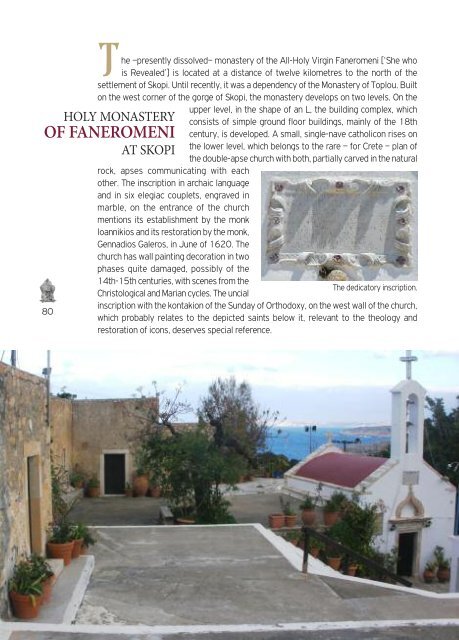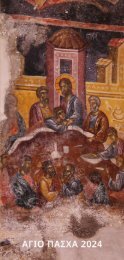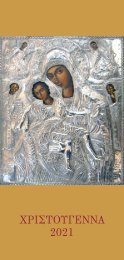Create successful ePaper yourself
Turn your PDF publications into a flip-book with our unique Google optimized e-Paper software.
The –presently dissolved– monastery of the All-Holy Virgin Faneromeni [‘She who<br />
is Revealed’] is located at a distance of twelve kilometres to the north of the<br />
settlement of Skopi. Until recently, it was a dependency of the Monastery of Toplou. Built<br />
on the west corner of the gorge of Skopi, the monastery develops on two levels. On the<br />
HOLY MONASTERY<br />
OF FANEROMENI<br />
AT SKOPI<br />
80<br />
rock, apses communicating with each<br />
other. The inscription in archaic language<br />
and in six elegiac couplets, engraved in<br />
marble, on the entrance of the church<br />
mentions its establishment by the monk<br />
Ioannikios and its restoration by the monk,<br />
Gennadios Galeros, in June of 1620. The<br />
church has wall painting decoration in two<br />
phases quite damaged, possibly of the<br />
14th-15th centuries, with scenes from the<br />
Christological and Marian cycles. The uncial<br />
upper level, in the shape of an L, the building complex, which<br />
consists of simple ground floor buildings, mainly of the 18th<br />
century, is developed. A small, single-nave catholicon rises on<br />
the lower level, which belongs to the rare – for Crete – plan of<br />
the double-apse church with both, partially carved in the natural<br />
The dedicatory inscription.<br />
inscription with the kontakion of the Sunday of Orthodoxy, on the west wall of the church,<br />
which probably relates to the depicted saints below it, relevant to the theology and<br />
restoration of icons, deserves special reference.<br />
The original three-aisled church, dedicated to St. John, the All-Holy Virgin and the<br />
Holy Trinity is the result of three successive interpolations to a single-nave, domed<br />
church of the middle Byzantine period. The church was expanded in the period of Venetian<br />
occupation with the addition of the south aisle, dedicated today to St. Charalambos. The<br />
two existing aisles were extended to the west in the 19th century<br />
and the north aisle was added at the same time, dedicated to the<br />
Holy Trinity. Three new doorframes were opened on the west<br />
side of the church, one for each aisle, of which the central one<br />
was formed monumentally being the base for the twin-lobed, tall,<br />
belfry. The church preserves wall painting decoration in its interior<br />
SAINT<br />
JOHN THE<br />
THEOLOGIAN<br />
AT MESA MOULIANA<br />
only in the apse of the sanctuary, which probably dates to the 14th century. The Deesis<br />
is depicted on the semi-dome of the apse and, on the semi-circle, five hierarchs with<br />
multi-cross chasubles who hold closed Gospels as well as St. Jacob, in the north corner,<br />
who appears to be accompanying the hierarchs, turned facing right, wearing the garment<br />
of an apostle and not of a hierarch as we find him in corresponding representations.<br />
81


















